
MARTIN MONTI/UCLA
The technique uses ultrasound to target the thalamus.
Bradley Crehan was hit by a car after walking out of a bar in Santa Monica, California, last February.
The 25-year-old's head slammed to the ground, causing a severe brain injury. His brain started to swell up, something that can cause serious permanent damage. According to Usha Lee McFarland of Stat News, who identified Crehan, doctors were forced to surgically remove part of his skull. The medical team induced a coma to help him recover.
Two weeks later, doctors were having trouble waking Crehan. He barely showed signs of consciousness and seemed to be in what doctors call a "minimally conscious state," according to a case report documenting the incident published in the journal Brain Stimulation.
Crehan could register some of what was said around him and perform small movements when doctors asked him to, but that was about it. After a severe brain injury or a coma, patients sometimes only partially awaken. These states of minimal awareness can last for years and the longer they last, the less likely a person is to ever fully wake up again.
So a University of California, Los Angeles research team decided to try to "jump-start" Crehan's thalamus, a region of the brain that helps regulate consciousness and process information, transmitting stimuli to other parts of the brain and helping us think, learn, and move.
Using a small ultrasound device - like those used to capture images of infants in the womb, but less powerful - the researchers fired a small amount of acoustic energy, or sound waves, directly at his thalamus.
Soon after, Crehan began to wake up. Within 24 hours, he was responding to doctors' requests much more clearly. Within three days, he was fully conscious and appeared to fully understand what was being said around him. He could even communicate for the first time by nodding his head to say "yes" or "no."
"The changes were remarkable," Martin Monti, a UCLA associate professor of psychology and neurosurgery who was the lead author of the case report, said in a press release. "It's almost as if we were jump-starting the neurons back into function."
Scientists have hoped that stimulating the thalamus might help patients recover from these minimally conscious states. In 2007, researchers used a brain implant to stimulate this region in the brain of a man who had been in one of these states for six years. He regained the ability to speak and the partial ability to move. But stimulating the brain in that way requires actually implanting something inside the brain, which can be dangerous and is expensive. Low-intensity focused ultrasound, which is what the UCLA team used on Crehan, is non-invasive.
Hopefully, doctors will be able to use this technique to help wake other patients from minimally conscious states. For now though, Monti cautions that they need to repeat this test in others before they know just how and why it works - if it even works at all.
"It is possible that we were just very lucky and happened to have stimulated the patient just as he was spontaneously recovering," he said.
Monti and other researchers plan on testing the same technology, which was developed by another UCLA researcher who was not involved in the study, on several other patients, starting this fall.